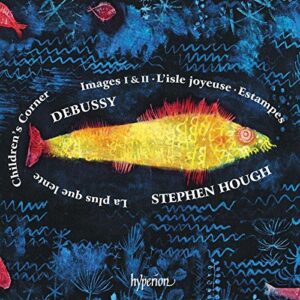Until now, Debussy’s music has eluded Stephen Hough’s eclectic discography, save for two short pieces. As it happens, his first all-Debussy release contains a good share of stunning, reference-worthy performances alongside some that fall short of Hough’s highest standard. In Estampes’ opening piece, Pagodes, for example, Hough’s ample tone and genial warmth tend to obscure detail; the indicated ritards are broad to the point of generic, while the pianist’s diffuse blending of left-hand chords against right-hand runs in the section marked sans lenteur conveys the opposite of Debussy’s “dans une sonorité plus claire” directive. Richter’s better balanced DG recording brings this passage’s gamelan-inspired polyphony into much bolder relief.
However, Hough’s sensitivity to La soirée dans Grenade’s sudden mood shifts and diverse levels of articulation are nothing less than a revelation. While Hough uncovers hidden melodies within Jardins sous la pluie’s toccata-like patterns, I prefer Jean-Efflam Bavouzet’s faster, more consistently soft execution. As for Images Book I, a lack of dynamic contrast prevents Reflets dans l’eau from taking colorful wing. Hough seems cognizant of Hommage à Rameau’s roots in the baroque Sarabande, yet certain important narrative arcs prove elusive. To be specific, Hough’s twitchy pacing of the chordal section marked trés soutenu (starting at measure 20) dissipates the build and momentum that Arturo Benedetti Michelangeli impeccably calibrates.
Nor does Hough make magic out of the important “morendo” transition leading into Mouvement’s triple-piano theme. However, Images Book II finds Hough on transcendental form. He brings ravishing nuance and subtle mobility to Cloches à travers les feuilles, while obtaining exquisitely delicate balances in Et la lune descend sur le temple qui fut. If Hough’s little marquee upbeats in Poissons d’or don’t match Aimard or Bavouzet for rhythmic élan, the central section marked Capricieux et souple conveys palpable point and humor.
The Children’s Corner Suite’s best moments include Hough’s uncommonly brisk and deadpan Jimbo’s Lullaby and an insouciantly strutting Golliwog’s Cake-walk. But Hough’s reserved and slightly square Doctor Gradus Ad Parnassum yields to label mate Angela Hewitt’s playfully varied articulations. La plus que lent has grown freer and more internalized in Hough’s seductive hands since the version included in Hyperion’s 2009 release “Stephen Hough in Recital”. Yet for all of Hough’s fastidious detailing in L’isle joyeuse, Bavouzet ultimately scores for crispness and cumulative drive, not to mention Vladimir Ashkenazy’s reference mid-1960s recording. Certainly this disc’s best selections are worth considering, with Hough’s Images Book II an easy winner.
































